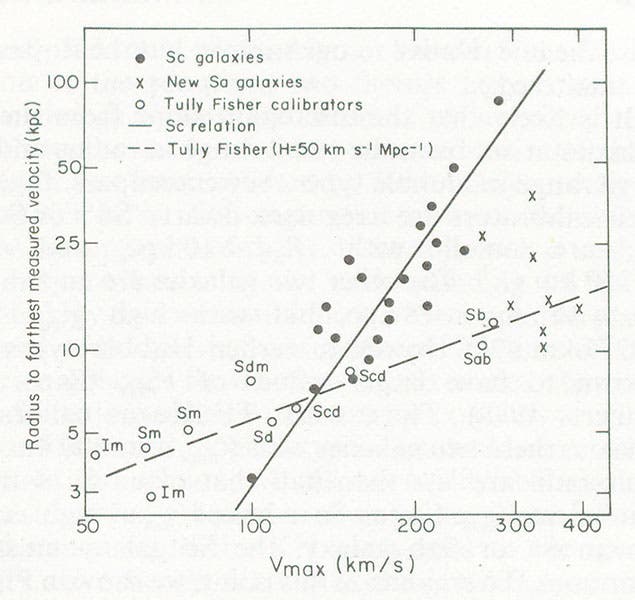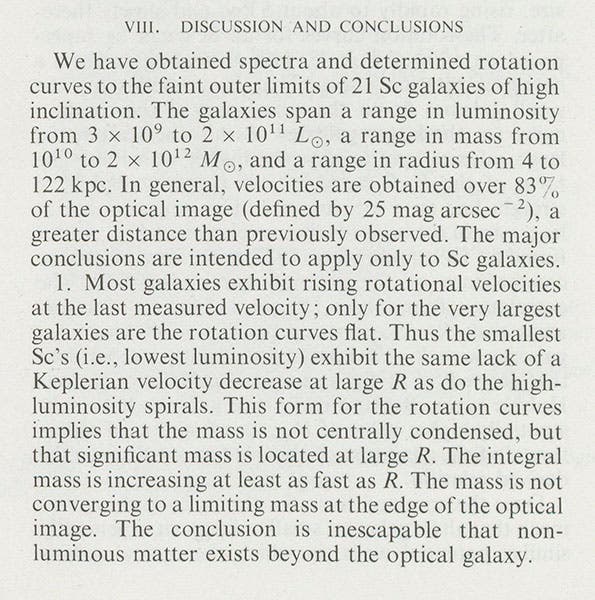Scientist of the Day - Vera Rubin
Vera Cooper Rubin, an American astronomer, was born July 23, 1928. Working at the Carnegie Institution of Washington, Rubin studied galaxies; to be specific, she measured galactic rotation rates. Galaxies not only look like they rotate – they are rotating. Rotating diffuse objects like collections of stars obey certain laws first formulated long ago by Johannes Kepler, so the rotation rates can be predicted once you know the basic parameters of a galaxy. Rubin discovered that rotating galaxies were not behaving as they should – the distant parts of the galaxies had rotational velocities that were far too large. The only way to make sense of the measurements was to assume that there is much more matter in a galaxy than we can see - dark matter. That was a pivotal discovery, announced by Rubin and her colleagues in the early 1980s. We are so used to cosmologists these days discussing dark matter and dark energy that we forget there was a time when astronomers assumed we can theoretically see everything that is out there. Rubin's work changed all that - nearly everything out there is stuff we cannot see.
Rubin published many important papers; we single out one here that Rubin herself noted as significant. It was called "Rotational Properties of 21 Sc Galaxies with a Large Range of Luminosities and Radii from NGC 4605 (R=4kpc) to UGC 2885 (R=122kpc)," published in the Astrophysical Journal in 1980 and co-written with W. K. Ford, Jr. and N. Thonnard. An Sc galaxy is an open spiral, with distinct arms whose velocity is easier to measure (although not easy by any other standard). As a specimen, we show a recent photograph released by European Southern Observatories of NGC 4321 (M100), one of the 21 galaxies studied by Rubin (second image).
From her article, we display here the first page (third image); a graph of galactic rotation velocities (fourth image), and the beginning paragraph of her "Discussion and conclusions," where she very specifically asserts that there must be matter in galaxies that we cannot see (fifth image).
Rubin's career has long provided an admirable example for working professional women everywhere. She married while still in graduate school and raised four children while pursuing her professional career (with the assistance of her equally admirable husband, Robert Rubin, in a marriage that lasted for 60 years, until death did them part). All four children went on to earn PhDs in various sciences, giving credit to Mom for demonstrating the value and attraction of a scientific career. In her early days, Rubin had to put up with continual slights by male astronomers and difficult-to-believe situations such as observatories that had no restrooms for women. But she persevered, and found her niche, and eventually showed astronomers that they were wrong in their presumptions about the visible universe.
Rubin also understood that we often think we understand the way things work, but we really don’t. That is why one pursues a scientific career, to push back the shadows. She was interviewed in 2000, and we will allow an excerpt from that interview to conclude our post. Said Rubin: “In a spiral galaxy, the ratio of dark-to-light matter is about a factor of 10. That’s probably a good number for the ratio of our ignorance to knowledge. We’re out of kindergarten, but only in about third grade.” Dr. William B. Ashworth, Jr., Consultant for the History of Science, Linda Hall Library and Associate Professor, Department of History, University of Missouri-Kansas City. Comments or corrections are welcome; please direct to ashworthw@umkc.edu.








![“Aurora Borealis,” hand-colored wood engraving by Josiah Wood Whymper, [Natural Phenomena], plate 2, 1846 (Linda Hall Library)](https://assets-us-01.kc-usercontent.com:443/9dd25524-761a-000d-d79f-86a5086d4774/0245ffcb-b70c-477c-8792-0a73ebd54eb2/Whymper%2011.jpg?w=210&h=210&auto=format&fit=crop)

